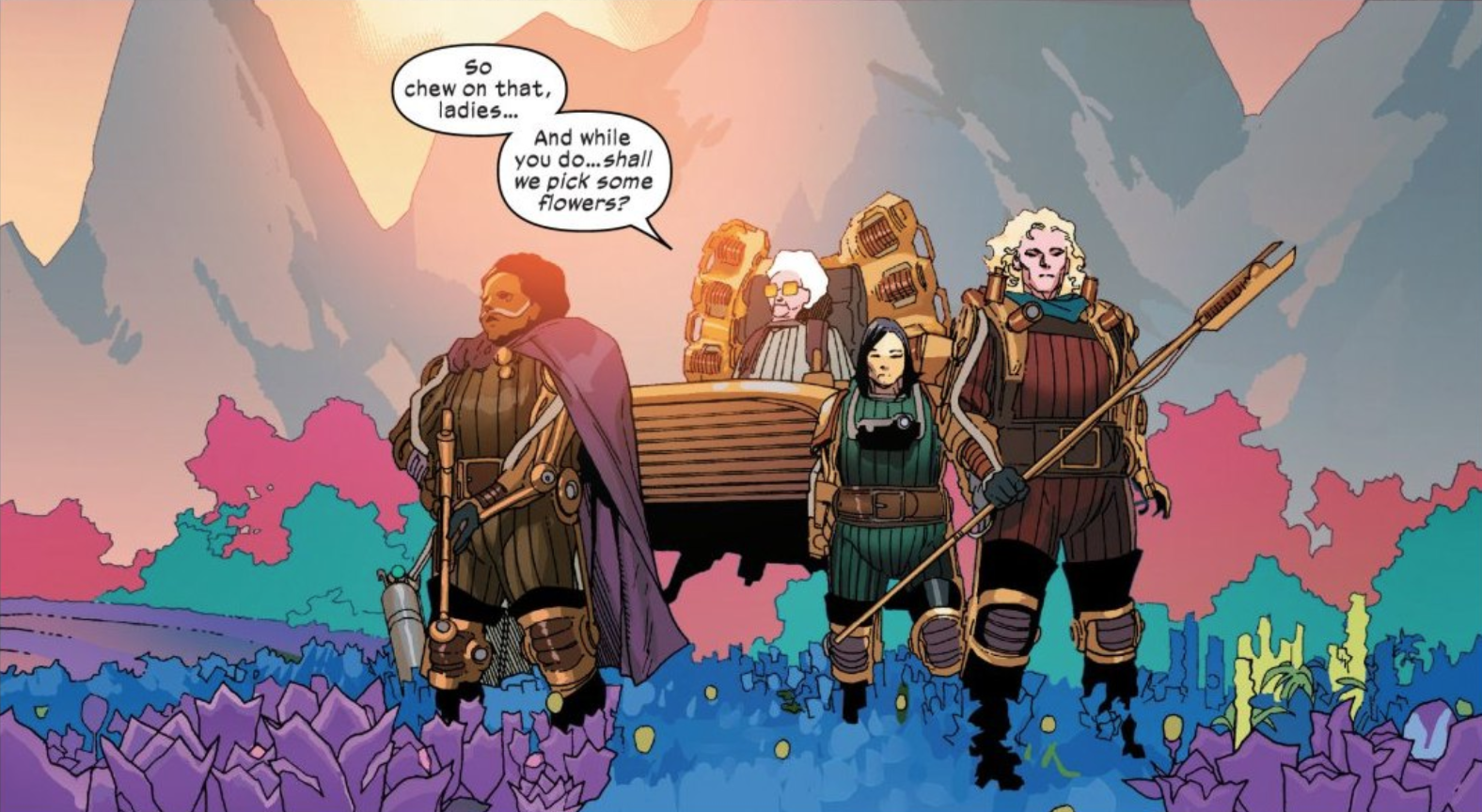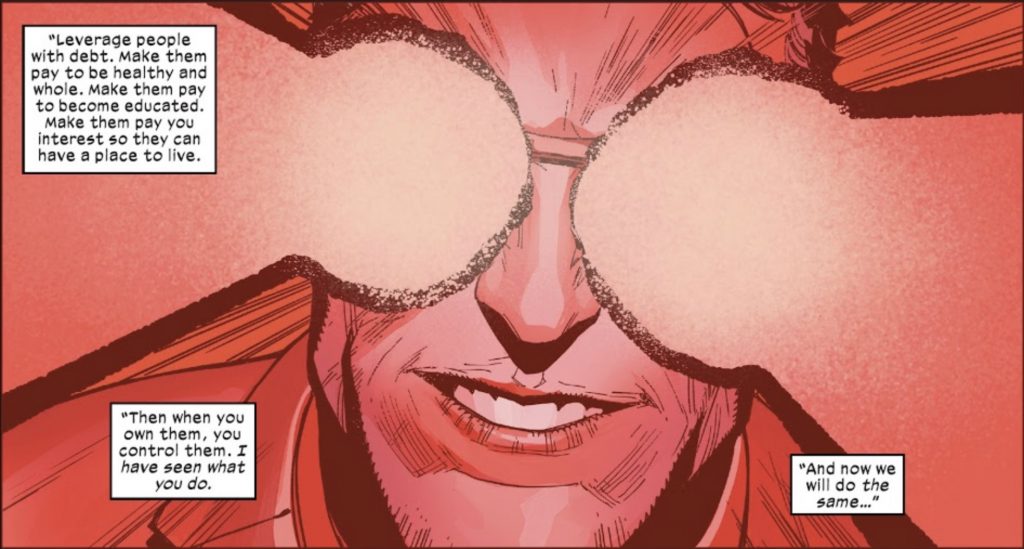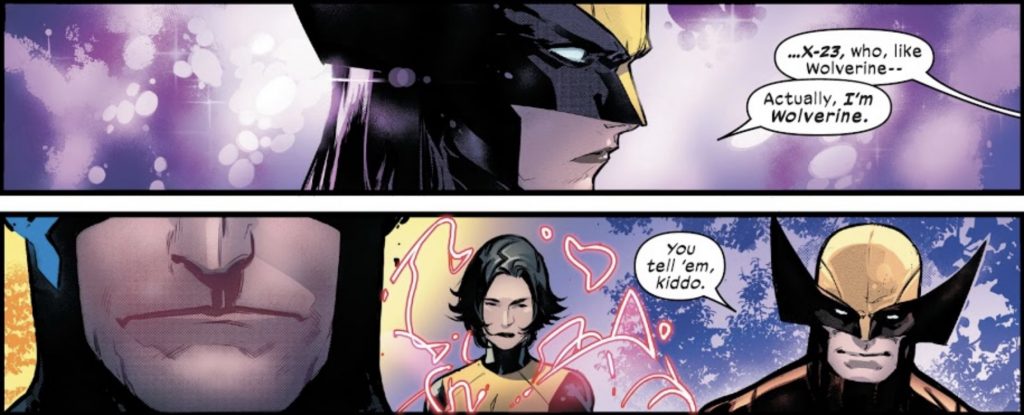The Dawn of X Character Power Rankings, as Decided by Science
Now that we’re six issues into the grand experiment that is Dawn of X – the name for the six launch titles for the X-Men line, post House of X and Powers of X 16 – I thought it might be time to look back on what we’ve read so far in X-Men, Marauders, New Mutants, X-Force, Excalibur and Fallen Angels. But I didn’t want to do it in the standard way. We’ve gotten plenty of reviews, thinkpieces and beyond already, so I wanted to zig while everyone else was zagging, and to do so using my favorite method: science. 17
That’s where the Dawn of X Character Power Rankings come in, as so far, we’ve seen a whole lot of exciting twists and turns for books and characters alike, but some figures in the titles are leading the way. I wanted to count down the 20 who are doing so for at least this one reader, and I wanted to try and do what I could to remove my personal biases from it. That’s where the science comes in. These power rankings are guided by a comic book variant of one of basketball’s most interesting stats: Net Rating Differential. In basketball, that means, simply put, how a player’s team performs with them on the court minus how they perform with them off the court. That creates a value that, in theory, speaks to their overall value to the team.
And hey, comic book characters are no different! There are some characters that show up and you’re immediately like, “Aw yeah, this is going to be a killer” and when they’re gone, you can feel that absence. This is designed to combine those two ideas into one singular rating speaking to the impact a character brings to a story, both when they are on page and off.
Of course, we don’t actually have ratings for characters for when they are on the page versus off the page, but never fear! That’s what I’m here for! I reread all of the issues I’ve bought so far – titles that are no longer in the mix for me naturally get a bit of a depreciation because of that – and then considered each character’s impact to the story. Using Giannis Antetokounmpo’s league leading +14.6 net rating and Tristan Thompson’s similarly league leading (league…anti-leading?) -11.3 net rating as my numbers guide, 18 I created a scale to see how each character fit within, figured out how they’d place, and then boom! I have ratings!
So let’s get to the Dawn of X Power Ratings, as governed by comic book NetRTG Differential.

20. The X-Desk
NetRTG Differential: 2.6
Let’s get weird from the jump! The X-Desk might strike some of you as an odd inclusion for multiple reasons, as a) it’s not a mutant, b) it’s not even an identified character, and c) it’s entirely driven by data pages. But the X-Desk data pages in Marauders are uniformly excellent and, despite their more text-based nature, maybe the best usage of the form thanks to the poor, conflicted person running The X-Desk’s brilliance as an exposition delivery device and someone with a genuine personality.
For those that don’t know, The X-Desk is seemingly a U.S. Naval officer whose job is to pay attention to what the Marauders are doing and their larger impact to the world, as well as intel related to Krakoa-based activities. And The X-Desk is not entirely a passive exercise, as their life is positively impacted by the mutant drugs, they struggle with the weight of their position, and they often betray the objectivity that their position likely asks for. It makes for a fascinating push/pull in the data pages that I love, and Gerry Duggan clearly delights in writing these each issue.
Here’s where I use the first ranking as an explainer, though. Because Marauders is a great book almost universally, the Off Page portion of the NetRTG Differential downgrades The X-Desk dramatically. The comic is a lot of fun when The X-Desk comes up. It’s even better when it isn’t there. That knocks it down considerably.

19. Hordeculture
NetRTG Differential: 2.7
The best completely new creation of Dawn of X so far goes to Hordeculture, the Golden Girls’ esque quartet of brilliant scientists who raid one of mutant’s flower farms that generate its inventory of life-changing drugs for humans in X-Men #3. They appeared in one issue, but that single appearance was an incendiary one, beautifully showcasing another type of reaction the mutants will face when it comes to their new world order: humans behaving opportunistically rather than violently. 19
It’s an ingenious move by Jonathan Hickman, as Hordeculture isn’t just used as a fun new villain, but as a mechanic to express another side of how humanity could react. Also, while the devil is often in the details, it’s worth noting delight can be as well: I personally enjoyed that a data page was used to reveal that Hordeculture’s current home base (they live in an ultra high tech mobile home, of course) is in Sedona, Arizona, a noted retirement community. Also one that’s quite close to where the Morlocks and their business as a Krakoan drug intermediary resides, as revealed in Marauders #7. Maybe it’s something, and maybe it isn’t. But it’s quite curious, indeed.

18. Murd Blurdock
NetRTG Differential: 3.5
Does Murd Blurdock appear in, like, a total of five pages in New Mutants? Yes. Does he say very little in total, with the majority of what he says equaling an abject failure at his sole purpose, which is being a space lawyer? Also yes. Is he basically space lizard Matt Murdock, and fundamentally a joke character? You can probably guess the answer.
But my guy Murd Blurdock has two things going for him. First, the dude is hilarious, and every single moment he’s on the page is hot fire. Second, his appearances reside in New Mutants, a title with one of the most naturally baked in differentials between issues due to how creative teams have alternated on the book. I love the guy, but he gets a bit of a system based lift here. I will say, though: the above data page is probably my favorite data page so far. It’s incredible.

17. Cyclops
NetRTG Differential: 3.6
And now, the first character appearing that could be defined as a main character to the story so far. The Cyclops we’ve gotten so far has been primarily in Jonathan Hickman and friends’ X-Men, and it’s been the most I’ve enjoyed the character in some time. Whether you’re talking him as a field leader in X-Men #1, off on safari with his kids in issue #2, or providing bodyguard services in issue #4, Cyclops has been joyous and competent in a way we rarely get. He’s been enlivened by Dawn of X.
So why is he down here at #17? Well, if Murd Blurdock gets a system lift, Cyclops gets killed by the curve of X-Men, my pick for the best Dawn of X title so far. Just look at the issues I noted in the previous paragraph. Cyclops was great in each, but he was the highlight in none of them. That hurts him from an OnOff standpoint, thus the spot down at 17.

16. Wolverine (Laura Kinney)
NetRTG Differential: 3.7
This is where dropping Fallen Angels does me a favor, as for the purposes of this exercise, I am largely pretending that comic was not a thing, especially considering the divide there was in characterization. Case in point: Laura “don’t not call me Wolverine” Kinney.
Like a character that’s soon to come, Laura appeared in one issue (outside of Fallen Angels): X-Men #5. But with the above two panel beat, she provided one of Dawn of X’s most iconic, unforgettable moments. In large lines like this where there are so many moving pieces and parts, it can be easy for characters to fall into the background and even lose their identity. But through her sheer force of will and Hickman’s gifts of knowing what characters (and arguably readers) need, Laura reclaimed her identity and earned the support of her namesake. It was a hell of a moment, an absolute banger in a series loaded with them.
There’s the downside: X-Men is laden with A-lister moments. It can be hard to compare to those. And unfortunately for her, her characterization in Fallen Angels was very, very weird. Without her appearances elsewhere, Laura very well could have finished higher, but this feels right considering.
subscribers only.
Learn more about what you get with a subscription
I’m not sure if they are still technically using that term now that a second wave has launched.↩
And by science, I mean extremely fake statistical methods that are also sort of real.↩
That’s with a minimum of 30 minutes per game, and these are for purely on court ratings.↩
There’s a little of the latter as well.↩
I’m not sure if they are still technically using that term now that a second wave has launched.↩
With X-Men/Fantastic Four getting a little consideration as well.↩
And by science, I mean extremely fake statistical methods that are also sort of real.↩
That’s with a minimum of 30 minutes per game, and these are for purely on court ratings.↩
There’s a little of the latter as well.↩
And I am including Magneto, Professor X and Moira in that.↩
Or perhaps fortunately, as he’s not much of a conversationalist.↩
Or I suppose she’s also like Liam Neeson in Taken, in that regard.↩
That said, it is a little weird that this character who is trying to get away from taking someone else’s identity does so by taking her brother’s identity.↩
Apologies if she was in the last three issues of Fallen Angels or something.↩
That’s another one of the top questions X-Men fans would have, I’d wager.↩
I’m not sure if they are still technically using that term now that a second wave has launched.↩
And by science, I mean extremely fake statistical methods that are also sort of real.↩
That’s with a minimum of 30 minutes per game, and these are for purely on court ratings.↩
There’s a little of the latter as well.↩
